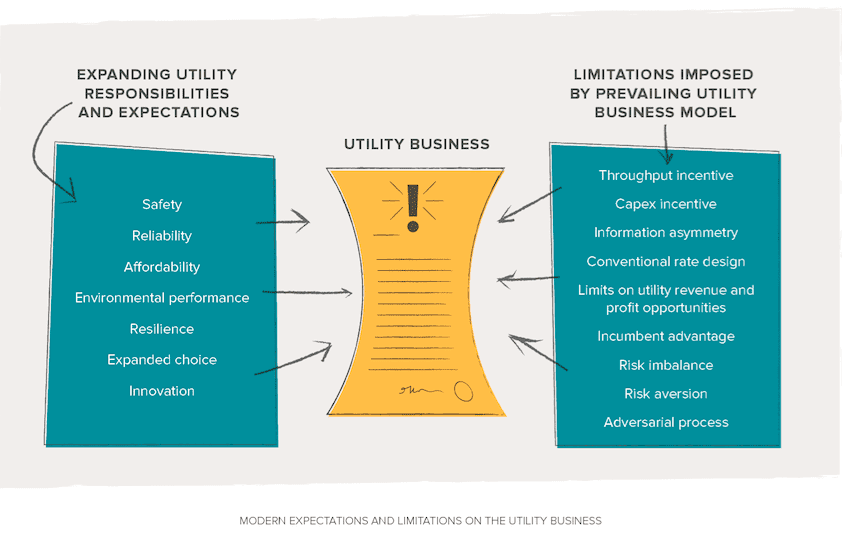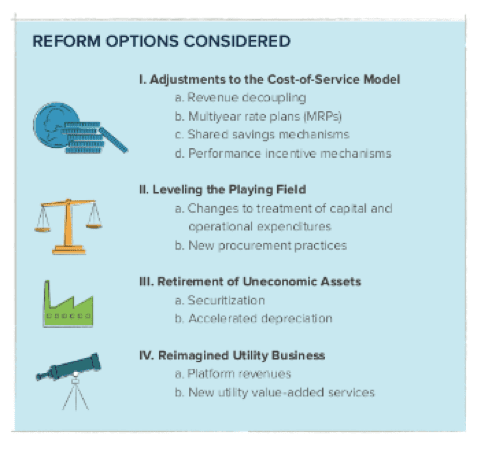
Report Release: A Practical Guide to Navigating Utility Business Model Reform
Last week’s election brings a wave of new leadership across the country. Twenty states elected new governors, including at least three—in Colorado, Michigan, and New Mexico—who have suggested adopting 100 percent renewable energy portfolio standards. The composition of many state legislatures will also shift, and these changes will in many cases result in policies that reshape states’ energy systems. Combined with underlying fundamentals of declining clean energy costs and new technical capabilities for advanced energy services, these changes continue a years-long trend to modernize the electric grid.
One way or another, all changes to the electricity system go through one key player: the electric utility. But utilities are limited in their ability to respond to current forces—be they economic, technological, or policy-driven. Utilities are regulated according to structures that were created for a bygone system of large, fossil fuel–powered generation. To build a modern grid suited to the next century’s needs, the utility business model needs to evolve, and in some circumstances, may need to transform. Numerous approaches are available to do so; however, it can be difficult to make sense of the options.
With Advanced Energy Economy Institute and America’s Power Plan, Rocky Mountain Institute released a new report to give actionable guidance on leading options to reform utilities’ business models. Navigating Utility Business Model Reform: A Practical Guide to Regulatory Design provides a menu of 10 options to guide policymakers as they work to modernize electric utilities. This guide is released in conjunction with a set of five case studies, which go into additional detail for how some of the reform options have been applied by select states and utilities, providing added insight into design options and lessons from past experience.
The Utility Business Model Is Not Prepared to Serve 21st-Century Needs
Powerful trends are impacting the electric system, including growing demands for improved environmental performance, the increasing availability of distributed energy resources like rooftop solar and storage, more customer demand for energy choice, and the need for strengthened resilience in the face of extreme weather events. Meanwhile, utilities must continue to deliver on traditional responsibilities of safety, reliability, and affordability—all while managing very different physical assets than they have historically.
There are significant new economic opportunities for utilities and other market players as a result of these trends; however, fundamental attributes of the utility business and regulatory framework inhibit them from reorienting to present-day needs. These barriers include financial incentives to grow energy sales and to invest in capital projects instead of more cost-effective solutions.

Policymakers Need Practical Guidance to Navigate Utility Business Model Reform
As US states advance efforts to modernize the grid, legislators and regulators increasingly face major policy decisions that affect the utility business. Participants in both legislative and regulatory activities, no matter the stage of reform, benefit from clear guidance on knowing the key questions and where to go to find helpful information. The list of jurisdictions grappling with these issues is long and is expected to grow longer.
Minnesota is one state at the front of the pack. Regulators there are investigating ways to expand performance-based regulation (PBR) for the state’s largest utility, Xcel. The Minnesota Public Utilities Commission (PUC) is exploring how additional performance metrics, as well as possible financial incentive mechanisms, can better align Xcel’s investments and operations with public policy objectives, including affordability and environmental performance. Developments over the next few months will establish a suite of metrics for Xcel, as well as new ways to encourage improved outcomes by the utility and across the power system.
In Ohio, stakeholders recently concluded an investigation into a range of grid issues, including distribution planning and rate design. The PUC of Ohio will soon begin the next stages of its PowerForward initiative, including further consideration of new utility procurement approaches that reduce system costs. As Ohio transitions from investigation toward decision-making, regulators, utilities, and other stakeholders will have the opportunity to create new solutions for system design.
As these and other states pursue reform, the need to update the utility business model will only increase. Navigating Utility Business Model Reform can help participants in reform activities develop more effective regulations to achieve these objectives.
A Catalog of 10 Reform Options to Modernize the Utility Business
The report focuses on 10 reform options, ranging from the relatively common (e.g., revenue decoupling) to more novel ideas (e.g., platform revenues). The set of options is not exhaustive, but reflects a range of responses to different pressures on the existing utility business model.
Although these options defy easy groupings, we provide a suggested categorization that organizes them according to similar approaches or objectives:
- Adjustments to the cost-of-service model
- Options that level the playing field and emphasize technology and resource neutrality
- Mechanisms that address retirement of uneconomic assets, such as coal power plants
- Reforms for a reimagined utility business
These options can be shaped in conjunction with other elements of the energy transition, including public policy shifts, new market structures, and advanced rate designs. The guide describes each option in simple terms while identifying best practices and key questions for reform proceedings. It also points to important references and past experience to support improved decision-making.
Of course, the best learning comes from direct experience with reforms. The accompanying case studies go into greater detail on the design and outcomes of some of the identified reforms:
- Performance incentive mechanism design for energy efficiency in Oklahoma
- A shared earnings mechanism for behavioral demand response in Maryland
- Changes to treatment of capital/operational expenditures for cloud computing services in New York and Illinois
- New procurement practices applied in the Brooklyn–Queens Demand Management program in New York City
- A multiple component PBR structure in the United Kingdom’s RIIO (Revenue = Incentives + Innovation + Outputs) framework
Putting the Pieces Together
Unfortunately, there is no easy playbook for modernizing the utility business model. Whereas this guide catalogs options and best practices for pursuing reform, implementation will be customized to the context of each state and utility. A few universal tenets are applicable, however, which the report discusses in more detail:
- Begin every reform activity with a clear articulation of goals and objectives.
- Make reforms fit for purpose (e.g., new grid investments) and scaled to the reform’s ambition.
- Encourage fair market development, including giving opportunities for competitive service providers, and ensure that utility roles are consistent with their monopoly charter.
- Make adaptiveness a central feature of the transition to new utility business models.
With a growing number of reform efforts underway, it’s clear that utilities, regulators, and other policymakers recognize the need for business model and regulatory change. By offering this guide, we hope that policymakers, utilities, and policy influencers can work together more effectively in understanding their options and taking these efforts further, faster, together.
Click here to download Navigating Utility Business Model Reform: A Practical Guide to Regulatory Design.
Click here to access five case studies that provide additional detail on key reform options.
